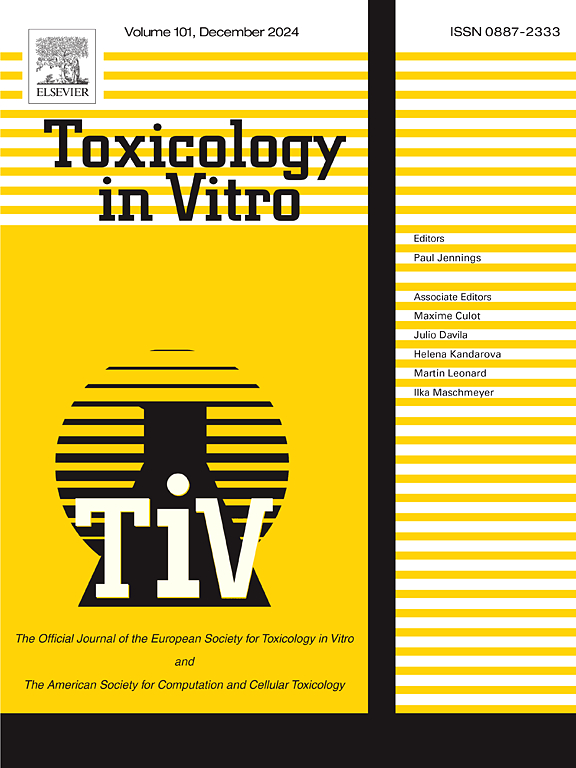Wistar大鼠和人肝细胞体外暴露于几种参考CAR/PXR核受体激活剂后甲状腺素(T4)代谢的显著差异
IF 2.6
3区 医学
Q3 TOXICOLOGY
引用次数: 0
摘要
我们的研究基于先前的发现(Baze等人,2024),通过在2D-sandwich中使用低温保存的原代Wistar大鼠肝细胞(PRH)和人肝细胞(PHH),研究CAR/PXR激活剂对甲状腺素(T4)代谢调节的物种差异,为期7天。每天暴露于苯巴比妥、5-孕酮-3β-醇-20- 1 -16α -碳腈(PCN)或地塞米松的PRH在过去24 h暴露中增加了T4清除率(分别比对照组增加了60 %、79 %和67 %)和T4-葡糖苷酸分泌(T4- g;最高可达463,661和545 pmol/106细胞,分别超过对照)。苯巴比妥和PCN的影响呈浓度依赖性,地塞米松的影响在最低浓度时最大,而利福平几乎不影响T4清除率和T4- g分泌。在任何测试浓度下,这些化合物都不影响PHH中的这些参数。此外,mRNA表达数据与CAR/PXR激活后大鼠和人肝脏中发生的I期Cyp/ Cyp、II期Ugt/ Ugt和III期Mrp2/ Mrp2通路的物种特异性和浓度依赖性调控一致。T4-UGT相对活性仅在PRH中升高,特别是PCN、地塞米松和苯巴比妥。比较PRH和PHH对化合物的反应是使用体外方法减少动物试验的重要一步。我们建议使用在PRH中观察到的相对T4-UGT活性阈值作为定义跨物种化合物相关效应的基准,帮助确定啮齿动物甲状腺效应的人类相关性。本文章由计算机程序翻译,如有差异,请以英文原文为准。
Marked differences in thyroxine (T4) metabolism following in vitro exposure of Wistar rat and human hepatocytes to several reference CAR/PXR nuclear receptor activators
Our study builds upon previous findings (Baze et al., 2024) by investigating species differences in thyroxine (T4) metabolism regulation by CAR/PXR activators using cryopreserved primary Wistar rat hepatocytes (PRH) and human hepatocytes (PHH) in 2D-sandwich over a 7-day treatment period. Daily exposure of PRH to phenobarbital, 5-Pregnen-3β-ol-20-one-16α‑carbonitrile (PCN) or dexamethasone increased T4 clearance over the last 24 h exposure (up to 60 %, 79 % and 67 % over control, respectively) and secretion of T4-glucuronide (T4-G; up to 463, 661 and 545 pmol/106 cells over control, respectively). Effects were concentration-dependent for phenobarbital and PCN and highest at the lowest concentration for dexamethasone, while rifampicin barely affected T4 clearance and T4-G secretion. None of the compounds, at any tested concentration, affected these parameters in PHH. Additionally, mRNA expression data were consistent with the species-specific and concentration-dependent regulation of phase I Cyp/CYP, phase II Ugt/UGT and phase III Mrp2/MRP2 pathways occurring in rat and human liver following CAR/PXR activation. T4-UGT relative activity increased in PRH only, specifically by PCN, dexamethasone and phenobarbital. The comparison of PRH and PHH responses to compounds represents an important step towards using in vitro methods to reduce animal testing. We recommend using relative T4-UGT activity thresholds observed in PRH as benchmarks for defining compound-related effects across species, helping determine the human relevance of thyroid effects in rodents.
求助全文
通过发布文献求助,成功后即可免费获取论文全文。
去求助
来源期刊

Toxicology in Vitro
医学-毒理学
CiteScore
6.50
自引率
3.10%
发文量
181
审稿时长
65 days
期刊介绍:
Toxicology in Vitro publishes original research papers and reviews on the application and use of in vitro systems for assessing or predicting the toxic effects of chemicals and elucidating their mechanisms of action. These in vitro techniques include utilizing cell or tissue cultures, isolated cells, tissue slices, subcellular fractions, transgenic cell cultures, and cells from transgenic organisms, as well as in silico modelling. The Journal will focus on investigations that involve the development and validation of new in vitro methods, e.g. for prediction of toxic effects based on traditional and in silico modelling; on the use of methods in high-throughput toxicology and pharmacology; elucidation of mechanisms of toxic action; the application of genomics, transcriptomics and proteomics in toxicology, as well as on comparative studies that characterise the relationship between in vitro and in vivo findings. The Journal strongly encourages the submission of manuscripts that focus on the development of in vitro methods, their practical applications and regulatory use (e.g. in the areas of food components cosmetics, pharmaceuticals, pesticides, and industrial chemicals). Toxicology in Vitro discourages papers that record reporting on toxicological effects from materials, such as plant extracts or herbal medicines, that have not been chemically characterized.
 求助内容:
求助内容: 应助结果提醒方式:
应助结果提醒方式:


